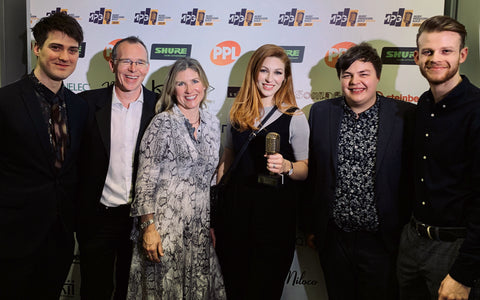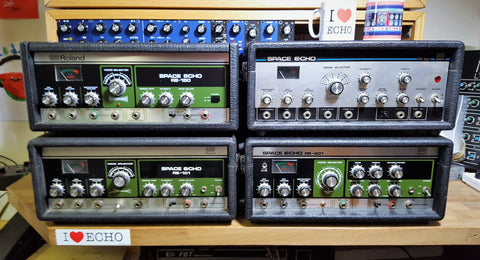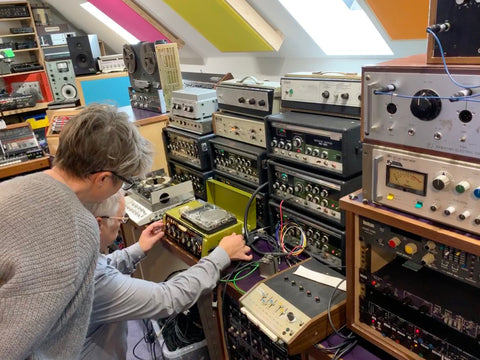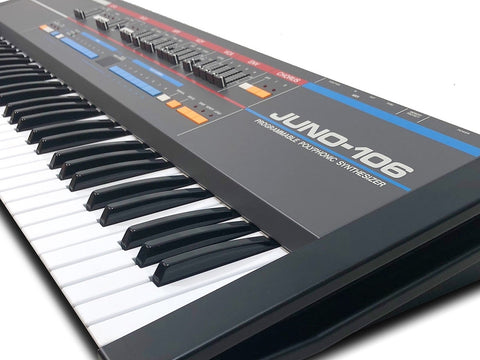Dynacord Echocord Studio: In Search Of The Magic Typewriter…
Nov 21 2018 1 Comment Tags: Dynacord, Echocord Studio, Gear History, repairs & mods, Tape / Disc Echo, tech talk
Are you sitting comfortably? Then I shall begin. I'd heard whispered rumours of a Dynacord echo that with a flat spinning disc instead of tape, but as my searches yielded no further information, I put it down to being just another vintage gear tall tale.
That was until a year or two later, when I happened upon what appeared to be a very stylish sixties typewriter, housed in a modest two tone carry case. Where a typewriter would ordinarily have a set of keys, this elegant machine had but a handful of buttons and knobs. A symphony of understated sixties German design, sporting classy curved lines with only discrete symbols denoting the various controls’ functions, it bore the legend, ‘Dynacord Echocord Studio’. My search was over and this beast was mythical no more. It was, however, in a pretty bad way and unlikely to be of much practical use without a full overhaul and even then there was doubt as to whether the disc/heads would pass muster.

The Echocord Studio and I are of a similar vintage: it was Introduced in 1966 and remained in production for two years, during which time only around 500 units were made. As it cost about a third of the price of a Volkswagen Beetle, this was certainly not a machine designed to weather the rigours of life on the road. It’s serious demeanour is a testament to its purpose as a high end studio piece.
The Doctor Will See You Now
Here at Soundgas, singular rare electromechanical devices requiring specialist attention tend to languish in Dr Huw’s ‘waiting room’ for very long time. This is especially true if they’re most likely to be retained by me for our studio ‘research’ purposes. Soundgas service department resources are stretched thin (if only you could clone techs), so anything we are considering keeping in the studio ranks below gear for our customers. So I was about to resign myself to a long wait to hear a fully-functional Echocord Studio when I was almost immediately offered two more that were in excellent condition. Better than busses it seems, Studios come in threes…
This was an exciting development: three examples made it worth investing Dr Huw’s valuable time in the Echocord Studio project, and they were duly entered on his medium term projects board. The second two units were in quite exceptional condition and, following initial inspection, it was reported that they could indeed be viable for restoration.

Discrete Germaniac
Even so, this proved a not inconsiderable task for our echo doctor: the Studio is a discrete device dating from the mid sixties, and the many boards are populated with capacitors that are well past their sell by date (see photos at the end of this article to see original caps bulging away). Some machines use all germanium transistors, and later ones a mix of germanium and silicon. While germanium transistors are much-lauded for their sound, especially when pushed into distortion, the passage of time has taken its toll and many are out of spec and very noisy. While none of this is beyond the good doctor’s wit, the flat ferrous oxide-coated disc with six heads resting lightly on the spinning recording medium, is a unique design and spare parts are unobtanium.
A Bad Case
Fortuitously, or perhaps not, we were about to receive a whole machine’s worth of spares. As one of the mint condition units was being carried over to our tech department, the carrying handle of the original case gave way, rudely introducing the very heavy and delicate machine to the tarmac of our car park at some velocity. The results were a completely smashed irreplaceable plastic lid, somewhat twisted outer casing, and a very red-faced junior technician who was suitably mortified at the carnage. Over the years, by accident or error, I've caused more damage to vintage equipment than most, so was sanguine about the mishap and told him not to worry as we now had a fine selection of spares to restore the other two machines. This proved especially handy when we later acquired a fourth unit, again in need of extra parts. The moral of the story is don’t ever trust old carrying handles…

Rise From Your Grave
Here at Soundgas, it’s not uncommon for restorations to be measured in years rather than weeks or months, especially if the gear is very old, unusual or just in a particularly bad way. It’s one of the hardest parts of running a business specialising in crumbling edge tech. Tying up much-needed cash in such gear for long periods makes little sense from a pure business perspective, but it is what keeps things interesting and is very much part of our raison d'être. There is more than financial value in granting an operational reprieve to a fine vintage machine such as an Echocord Studio - rather than consigning it to an electronic graveyard; and being able to add it to our roster of possible future rescues and repairs is always cause for quiet celebration. This is at the heart of our mission: to search the outer reaches of vintage gear and discover and bring back the otherwise irredeemable.
See the photos at the end of this post for a selection of shots from the restoration process.
Spinning Wheel
To receive the first fully-functioning unit back from Dr Huw less than six months later was a joy, and vindicated the decision to gamble on that first unpromising machine. It was also very much a revelation: I’ve had many electromechanical echoes over the years, including several other designs using a coated disc rather than tape (or a Binson’s wire-wrapped metal drum), and they have all had a unique and enjoyable sound, but this was in another league entirely.

The Echocord Studio’s combination of discrete circuitry, germanium preamps and sixties Teutonic over-engineered build quality, add up to a very special and truly unique machine. The four playback heads can be used in various gratifying combinations, and the two-speed motor - engaged by a large switch on the right hand side with a very pleasing action - offers an excellent range of echo possibilities. The little black and white dial on top of the disc, visible through the small circular viewing window atop the unit, offers a delightful visual representation of the machine’s status.
Blink And You’ll Miss It
The sound of this first unit was stunning: it possessed all the qualities one could wish for in a good analogue echo, with a reverb-like swell as well as excellent repeats and sounding superb when overdriven, thanks to those now-tamed germanium transistors. Dr Huw had done a fine job; it was not noticeably noisier in operation than other good examples of well-restored tape echoes, and I was utterly-captivated. The ability to mix four input signals with individual control of bass and treble (via wheels above the input sockets), and the dry and wet amounts for each channel, made for a flexible and powerful processor.
Sadly, the insatiable demands of a cash-hungry growing business meant it was for sale and sold within a matter of days, and it was to be another year before Dr Huw’s schedule would permit the next machine to live again.
Go Slow
It’s been quite a tumultuous and hectic twelve months at Soundgas, with many rapid changes in our evolution that have impacted on our ability to deliver the very best in vintage gear. One of the most significant being the decision to invest a great deal of Dr Huw’s precious time in developing and improving our Binson restorations, including our super slow varispeed motor modification. As a result, the remaining two potentially viable Echocord Studios have stood neglected all this time.
Finally, a month or so ago, we were able to recommence Dr Huw’s Echocord Studio restoration project, but this time with the exciting news that it could be possible to modify the next one with the same super-slow varispeed motor option as used in our Binson Echorecs. Again this required a good deal of extra bench time to bring to fruition, but the result was well worth it. Dr Huw’s carefully thought out design niftily incorporates the varispeed control into the original side-mounted switch which controls the rotary pot from on/off through very slow to faster repeats. The finished machine was duly tested to great approval and offered for sale via our weekly mail out.
There Can Be Only One
Having listed the finished machine, we immediately set it to work in the Soundgas Studio on a session, using it to add detuned ambience on some dark string parts being processed for a soundtrack. It proved an absolute joy to use; the varispeed implementation is seamless and feels integral to the original design (which it surely would have been had the technology at the time allowed).
After only an hour at work, it became very apparent that we had something truly special in our hands: a one-of-a-kind sound-processing device that is as pleasing to play as it is sonically. There was a chance that this initial soundtrack session could develop into an ongoing project: how could we sell this machine that was, at that moment, the star turn?
Here are two more instagram posts featuring that machine:
Out Of Reach
It’s not an easy decision to remove from sale something that is the result of eighteen months’ investment, but it had to be done. So this extraordinary individual Echocord Studio now resides in the Soundgas Studio as part of our armoury of very special sound processing devices that are at our customers’ disposal via our remote studio access facility.
This is not the end of the story: we still have one viable machine, currently on Dr Huw’s bench and well on the way to completion with a full varispeed modification (and wet-only output) which should be available via the mailing list very soon: sign up to be informed when it’s ready. You won’t regret it - I rate the varispeed Echocord Studio as one of the finest and most playable echo machines I've had the privilege of using.
And if you have an odd cream-coloured typewriter-shaped device languishing unused in a forgotten corner, please do get in touch: we’d welcome the chance to acquire further examples for Dr Huw to work his magic on. We regret however that the amount of work required to resurrect these machines means we are currently unable to undertake service work on machines other than our own.
==========
Those electronically-minded individuals who wish to know more about the design, can find the schematic here.
More shots of the internals and restoration process below. This first one is just some of the out of spec capacitors that Huw had to remove from one machine!


All photos and information Copyright Soundgas Limited 2018 - if you want to repost some of what is here please ask and we will usually give permission if credit is given. And if you link to this post then tell us and we will give you a mention on social media!
1 Comment











hi . i need some simple advice from Dr Huw if possible… i have a phillips EL6910 delay. uses a solid disk with an oxide coated edge. the disk spins past erase ,record, and 4 playback heads. i need to recoat the oxide. can u advise what product i can use please.
Leave a Comment